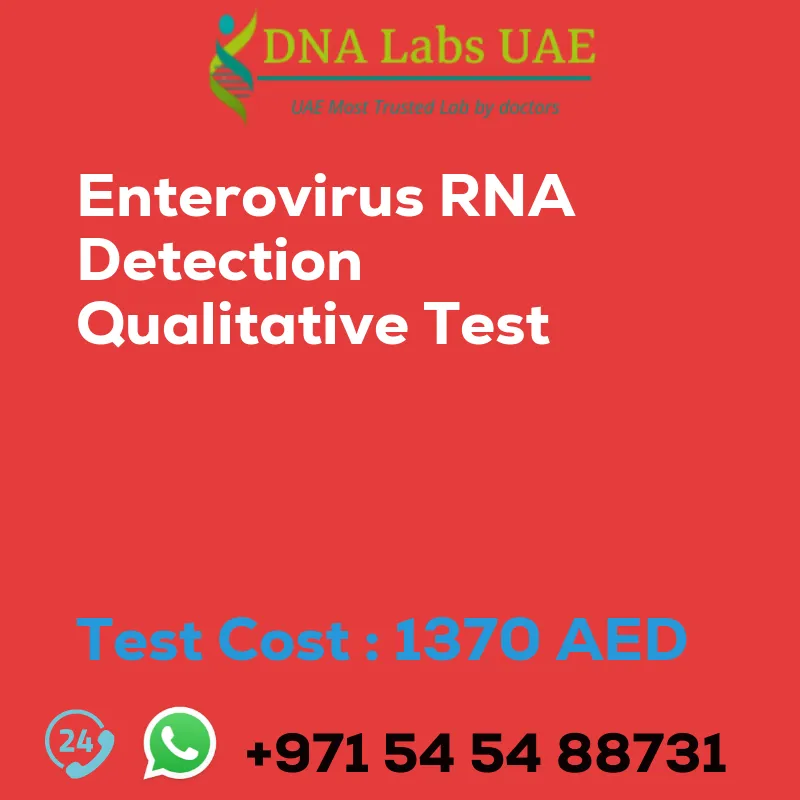Enterovirus RNA Detection Qualitative Test
At DNA Labs UAE, we offer the Enterovirus RNA Detection Qualitative Test to detect the presence of enteroviruses in a patient’s sample. Enteroviruses can cause various illnesses, including respiratory infections, gastrointestinal infections, and neurological diseases.
Test Details
The Enterovirus RNA Detection Qualitative Test is a laboratory test that specifically detects the viral RNA of enteroviruses in the patient’s sample. The test is based on the polymerase chain reaction (PCR) technique, which amplifies the viral RNA to a detectable level.
Components and Price
The cost of the Enterovirus RNA Detection Qualitative Test is 1370.0 AED. The test can be performed on whole blood, serum, stool, cerebrospinal fluid (C.S.F), and plasma samples.
Report Delivery
The test results will be delivered via email within 3rd working day. For urgent inquiries, results can be obtained over the phone within 24 hours.
Method and Test Type
The Enterovirus RNA Detection Qualitative Test uses the Real Time PCR method, which is a highly sensitive and specific technique for viral detection. The test falls under the category of viral tests.
Test Department and Doctor
The Enterovirus RNA Detection Qualitative Test is conducted in our Genetics department under the supervision of our experienced physicians.
Pre Test Information
Prior to the test, patients are required to sign a consent document and provide any relevant clinical history of the patient for Enterovirus (RNA Detection) Qualitative Test.
Test Process
The Enterovirus RNA Detection Qualitative Test involves the following steps:
- Sample collection: A respiratory tract swab or stool sample is collected from the patient. The sample is then transported to the laboratory under appropriate conditions to maintain the integrity of the viral RNA.
- RNA extraction: The viral RNA is extracted from the patient’s sample using specialized laboratory techniques. This step is crucial to isolate the viral genetic material for further analysis.
- Reverse transcription: The extracted RNA is converted into complementary DNA (cDNA) using an enzyme called reverse transcriptase. This step allows the RNA to be converted into a more stable form for PCR amplification.
- PCR amplification: The cDNA is then subjected to PCR amplification using specific primers that target the enterovirus RNA. PCR amplification involves multiple cycles of heating and cooling, which allows the viral RNA to be exponentially replicated.
- Detection: The amplified DNA is then analyzed using various methods, such as gel electrophoresis or real-time PCR, to determine the presence or absence of enterovirus RNA. A positive result indicates the presence of enterovirus RNA in the patient’s sample.
Benefits of the Test
The Enterovirus RNA Detection Qualitative Test is a highly sensitive and specific method for detecting enteroviruses. It is often used in clinical settings to diagnose enterovirus infections and guide appropriate treatment decisions. The test results can help healthcare providers determine the cause of the patient’s symptoms and provide appropriate care.
| Test Name | Enterovirus RNA Detection Qualitative Test |
|---|---|
| Components | |
| Price | 1370.0 AED |
| Sample Condition | Whole Blood, Serum, Stool, C.S.F, Plasma |
| Report Delivery | 3rd Working Day Email:-36 hours.On phone: 24 hours |
| Method | Real Time PCR |
| Test type | Viral |
| Doctor | Physician |
| Test Department: | Genetics |
| Pre Test Information | Need to sign Consent document and bring any clinical history of patient forEnterovirus (RNA Detection) QualitativeTest |
| Test Details |
The Enterovirus (RNA Detection) Qualitative Test is a laboratory test used to detect the presence of enteroviruses in a patient’s sample. Enteroviruses are a group of viruses that can cause various illnesses, including respiratory infections, gastrointestinal infections, and neurological diseases. This test specifically detects the viral RNA (genetic material) of enteroviruses in the patient’s sample, usually collected from the respiratory tract or stool. It is based on the polymerase chain reaction (PCR) technique, which amplifies the viral RNA to a detectable level. The test involves the following steps: 1. Sample collection: A respiratory tract swab or stool sample is collected from the patient. The sample is then transported to the laboratory under appropriate conditions to maintain the integrity of the viral RNA. 2. RNA extraction: The viral RNA is extracted from the patient’s sample using specialized laboratory techniques. This step is crucial to isolate the viral genetic material for further analysis. 3. Reverse transcription: The extracted RNA is converted into complementary DNA (cDNA) using an enzyme called reverse transcriptase. This step allows the RNA to be converted into a more stable form for PCR amplification. 4. PCR amplification: The cDNA is then subjected to PCR amplification using specific primers that target the enterovirus RNA. PCR amplification involves multiple cycles of heating and cooling, which allows the viral RNA to be exponentially replicated. 5. Detection: The amplified DNA is then analyzed using various methods, such as gel electrophoresis or real-time PCR, to determine the presence or absence of enterovirus RNA. If the enterovirus RNA is present in the patient’s sample, a positive result is obtained. The Enterovirus (RNA Detection) Qualitative Test is a highly sensitive and specific method for detecting enteroviruses. It is often used in clinical settings to diagnose enterovirus infections and guide appropriate treatment decisions. The test results can help healthcare providers determine the cause of the patient’s symptoms and provide appropriate care. |








